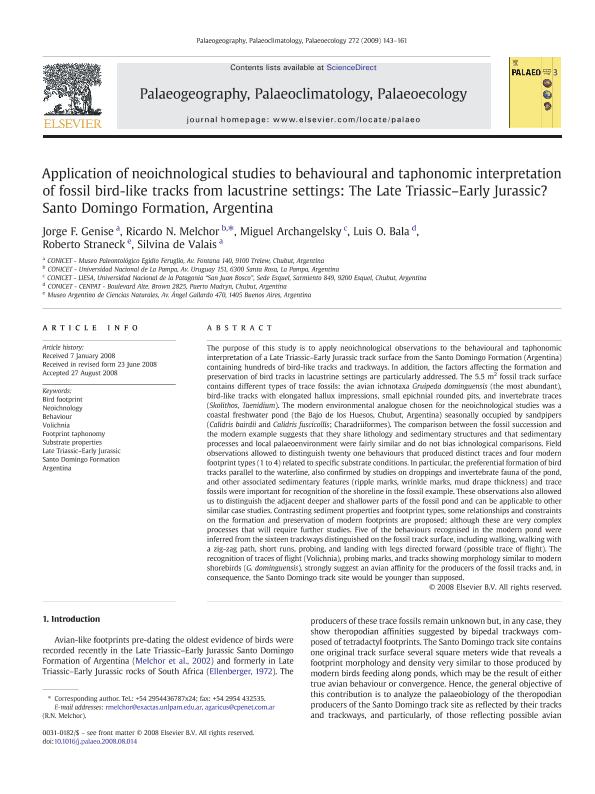Artículo
Application of neoichnological studies to behavioural and taphonomic interpretation of fossil bird-like tracks from lacustrine settings: The Late Triassic-Early Jurassic? Santo Domingo Formation, Argentina
Genise, Jorge Fernando ; Melchor, Ricardo Nestor
; Melchor, Ricardo Nestor ; Archangelsky, Miguel
; Archangelsky, Miguel ; Bala, Luis Oscar
; Bala, Luis Oscar ; Straneck, Roberto Juan
; Straneck, Roberto Juan ; de Valais, Silvina
; de Valais, Silvina
 ; Melchor, Ricardo Nestor
; Melchor, Ricardo Nestor ; Archangelsky, Miguel
; Archangelsky, Miguel ; Bala, Luis Oscar
; Bala, Luis Oscar ; Straneck, Roberto Juan
; Straneck, Roberto Juan ; de Valais, Silvina
; de Valais, Silvina
Fecha de publicación:
02/2009
Editorial:
Elsevier Science
Revista:
Palaeogeography, Palaeoclimatology, Palaeoecology
ISSN:
0031-0182
Idioma:
Inglés
Tipo de recurso:
Artículo publicado
Clasificación temática:
Resumen
The purpose of this study is to apply neoichnological observations to the behavioural and taphonomic interpretation of a Late Triassic-Early Jurassic track surface from the Santo Domingo Formation (Argentina) containing hundreds of bird-like tracks and trackways. In addition, the factors affecting the formation and preservation of bird tracks in lacustrine settings are particularly addressed. The 5.5 m2 fossil track surface contains different types of trace fossils: the avian ichnotaxa Gruipeda dominguensis (the most abundant), bird-like tracks with elongated hallux impressions, small epichnial rounded pits, and invertebrate traces (Skolithos, Taenidium). The modern environmental analogue chosen for the neoichnological studies was a coastal freshwater pond (the Bajo de los Huesos, Chubut, Argentina) seasonally occupied by sandpipers (Calidris bairdii and Calidris fuscicollis; Charadriiformes). The comparison between the fossil succession and the modern example suggests that they share lithology and sedimentary structures and that sedimentary processes and local palaeoenvironment were fairly similar and do not bias ichnological comparisons. Field observations allowed to distinguish twenty one behaviours that produced distinct traces and four modern footprint types (1 to 4) related to specific substrate conditions. In particular, the preferential formation of bird tracks parallel to the waterline, also confirmed by studies on droppings and invertebrate fauna of the pond, and other associated sedimentary features (ripple marks, wrinkle marks, mud drape thickness) and trace fossils were important for recognition of the shoreline in the fossil example. These observations also allowed us to distinguish the adjacent deeper and shallower parts of the fossil pond and can be applicable to other similar case studies. Contrasting sediment properties and footprint types, some relationships and constraints on the formation and preservation of modern footprints are proposed; although these are very complex processes that will require further studies. Five of the behaviours recognised in the modern pond were inferred from the sixteen trackways distinguished on the fossil track surface, including walking, walking with a zig-zag path, short runs, probing, and landing with legs directed forward (possible trace of flight). The recognition of traces of flight (Volichnia), probing marks, and tracks showing morphology similar to modern shorebirds (G. dominguensis), strongly suggest an avian affinity for the producers of the fossil tracks and, in consequence, the Santo Domingo track site would be younger than supposed.
Archivos asociados
Licencia
Identificadores
Colecciones
Articulos(CCT - PATAGONIA NORTE)
Articulos de CTRO.CIENTIFICO TECNOL.CONICET - PATAGONIA NORTE
Articulos de CTRO.CIENTIFICO TECNOL.CONICET - PATAGONIA NORTE
Articulos(CCT-CENPAT)
Articulos de CTRO.CIENTIFICO TECNOL.CONICET - CENPAT
Articulos de CTRO.CIENTIFICO TECNOL.CONICET - CENPAT
Articulos(INCITAP)
Articulos de INST.D/CS D/L/TIERRA Y AMBIENTALES D/L/PAMPA
Articulos de INST.D/CS D/L/TIERRA Y AMBIENTALES D/L/PAMPA
Articulos(MACNBR)
Articulos de MUSEO ARG.DE CS.NAT "BERNARDINO RIVADAVIA"
Articulos de MUSEO ARG.DE CS.NAT "BERNARDINO RIVADAVIA"
Articulos(SEDE CENTRAL)
Articulos de SEDE CENTRAL
Articulos de SEDE CENTRAL
Citación
Genise, Jorge Fernando; Melchor, Ricardo Nestor; Archangelsky, Miguel; Bala, Luis Oscar; Straneck, Roberto Juan; et al.; Application of neoichnological studies to behavioural and taphonomic interpretation of fossil bird-like tracks from lacustrine settings: The Late Triassic-Early Jurassic? Santo Domingo Formation, Argentina; Elsevier Science; Palaeogeography, Palaeoclimatology, Palaeoecology; 272; 3-4; 2-2009; 143-161
Compartir
Altmétricas



